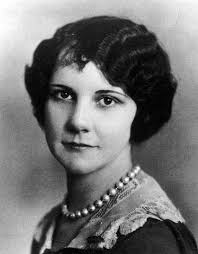It wouldn't be proper to begin this blog series on Luminous Women with anyone besides Catherine Wolfe Donohue. This quiet Catholic woman from Ottawa, Illinois inspired her friends, courageously challenged the radium industry, and made law-changing history in the United States. Her place in history is not one to which she aspired, but when injustice would have reigned Catherine gave voice to the vulnerable.
Catherine Wolfe was born in 1903 in a midwestern town snugly settled along the banks of the Fox River. She was baptized, married, and took her first communion at Ottawa's St Columba, and went to school with the same young people she attended church with. When she was 19, she took a job at the company across the road from St Columba. Radium Dial had taken up residence in the old high school, and they hired young women to paint the fine numbers and lines on watches and instruments with radium infused paint to make them glow in the dark.
This was an excellent opportunity for Catherine and her friends. Working in a painting studio was more sophisticated and higher paying than domestic service or factory work. A quiet girl, Catherine formed close connections with her coworkers. She married Thomas Donohue in January 1932, just a few months after being fired from Radium Dial for poor health and a visible limp.
It would have been tempting for Catherine to settle into being a housewife and raising children, but she was concerned about her health, even more so because some of her young friends had died in recent years making Catherine wonder if there wasn't something dangerous in the paint they used in Radium Dial's studio. The radium industry by this time was well aware of the dangers of the luminescent paint, but inconsistent and underplayed efforts had been made to ensure the dial painters' safety. Radium Dial had briefly given the women glass pens to apply the paint with to stop the practice of lip-pointing brushes, but they were quickly discarded since the brushes were more efficient.

The brushes were also how radium entered women's bodies. Trained to dip their brush in the paint, point the bristles with their lips, and then paint the tiny numbers on their dials, women like Catherine had been ingesting the radioactive substance for years. Initially told that radium was good for their health, as medical professionals did briefly believe, the women were not informed when new research and multiple deaths proved that people had been wrong about radium.
Profit is king, and Radium Dial continued operations until forcibly closed, long after the death of Catherine Donohue and others like her. In fact, Radium Dial had taken strides to protect it's cash and resources before Catherine's law suit was judged. It wasn't until her hearing before the Illinois Industrial Commission that Catherine and her co-litigants learned that only $10,000 in assets could possibly be paid - if they won - because Radium Dial's assets had been transferred to a new business. Luminous Processes operated just a few blocks away from Radium Dial's old schoolhouse.
Suffering horribly from radium poisoning, Catherine testified about her years at Radium Dial. She weighed less than 70 pounds. Her teeth and jaw bone were falling out, and a huge tumor grew on her hip. Catherine was carried into the room to make sure the court heard what was happening to dial painters. Only when a doctor was asked to testify as to her prognosis did Catherine finally break down and fully accept that she was dying.
The hearing continued in the Donohue home, so that Catherine could complete her testimony tucked in on the family sofa. Scarcely able to move and her words slurred by the deformation of her mouth, Catherine demonstrated how she had created a fine point on her brushes with her lips and poisoned herself irreversibly.
Catherine was victorious in her case before the Illinois Industrial Commission, and new worker compensation and employee safety laws began to be drafted, but Catherine never saw any of the settlement Radium Dial was ordered to pay. She died on July 27, 1938, while Radium Dial was still filing appeals. Final victory was bittersweet when the Supreme Court refused to hear Radium Dial's appeal and Tom, Catherine's grieving and bankrupted widower, received about $5,700, a fraction of the amount that had been spent on his suffering wife's medical bills.

Catherine's true victory came in raised awareness of the dangers of radium and worker exploitation. This could not save her or end the suffering of her friends, but it did decrease the chances that it would happen to another generation of working class women. The women's cases of radium poisoning also informed researchers during World War II and led to strict precautions in how radioactive substances are handled. It was one of Catherine's last hopes that, though she would die, she would be able to help and protect others.
~~~~~~~~~~~~~~~~~~~~~~~~~
Learn more about Catherine Wolfe Donohue and the other radium girls of Ottawa, Illinois in
Luminous: The Story of a Radium Girl.
Available for Kindle and paperback on Amazon worldwide.
"It's too late for me, but maybe it will help some of the others."
- Catherine Wolfe Donohue
~~~~~~~~~~~~~~~~~~~~~~~~~
Other suggested reading:
Radium Girls: Women and Industrial Health Reform, 1910-1935 by Claudia Clark
The Radium Girls: The Dark Story of America's Shining Women by Kate Moore
















































